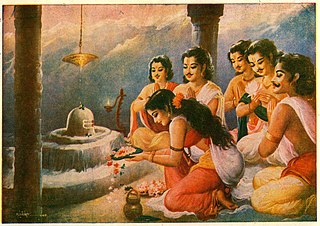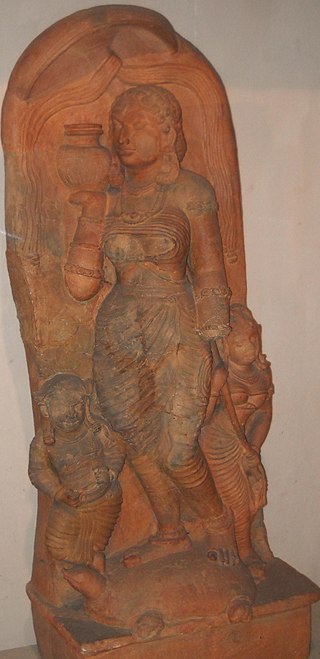
Kamadhenu, also known as Surabhi, is a divine bovine-goddess described in Hinduism as the mother of all cows. She is a miraculous cow of plenty who provides her owner whatever they desire and is often portrayed as the mother of other cattle. In iconography, she is generally depicted as a white cow with a female head and breasts, the wings of a bird, and the tail of a peafowl or as a white cow containing various deities within her body. Kamadhenu is not worshipped independently as a goddess. Rather, she is honored by the Hindu veneration of cows, who are regarded as her earthly embodiments.

Draupadi, also referred to as Krishnā, Panchali, and Yajnaseni, is the main female protagonist of the ancient Indian epic Mahabharata, and the wife of the five Pandava brothers—Yudhishthira, Bhima, Arjuna, Nakula, and Sahadeva. She is noted for her beauty, courage and polyandrous marriage.

Bhishma, also known as Pitamaha, Gangaputra, and Devavrata, is a central figure in the Hindu epic Mahabharata. He was a prince, statesman, and military commander of the ancient Kuru Kingdom. Renowned for his wisdom, valor, and unwavering principles, Bhishma served as the supreme commander of the Kaurava forces during the Kurukshetra War.

Karna, also known as Vasusena, Anga-Raja, Sutaputra and Radheya, is one of the major characters in the Hindu epic Mahābhārata. He is the son of Surya and princess Kunti. Kunti was granted the boon to bear a child with desired divine qualities from the gods and without much knowledge, Kunti invoked the sun god to confirm it if it was true indeed. Karna was secretly born to an unmarried Kunti in her teenage years, and fearing outrage and backlash from society over her premarital pregnancy, Kunti had to abandon the newly born Karna adrift in a basket on the Ganges. The basket is discovered floating on the Ganges River. He is adopted and raised by foster Suta parents named Radha and Adhiratha Nandana of the charioteer and poet profession working for king Dhritarashtra. Karna grows up to be an accomplished warrior of extraordinary abilities, a gifted speaker and becomes a loyal friend of Duryodhana. He is appointed the king of Anga (Bihar-Bengal) by Duryodhana. Karna joins the losing Duryodhana side of the Mahabharata war. He is a key antagonist who aims to kill Arjuna but dies in a battle with him during the Kurushetra war.
Vichitravirya is a figure in the Mahabharata, where he is featured as a Kuru king.

Urvashi is the most prominent apsara mentioned in the Hindu scriptures like the Vedas, the epics Ramayana and Mahabharata, as well as the Puranas. She is regarded as the most beautiful of all the apsaras, and an expert dancer.

Ashtavakra is a revered Vedic sage in Hinduism. His maternal grandfather was the Vedic sage Aruni, his parents were both Vedic students at Aruni's school. Ashtavakra studied, became a sage and a celebrated character of the Hindu Itihasa epics and Puranas.

Hindu mythological wars are the wars described in the Hindu texts of ancient India. These wars depicted both mortals of great prowess as well as deities and supernatural beings, often wielding supernatural weapons of great power. Hindu teachings prescribe war as the final option, to be employed only after all peaceful methods are exhausted. Participation in righteous war, or dharmayuddha, was said to be honourable and was a principal duty of the Kshatriya or the warrior varna, and victory in such wars was regarded as a matter of honour.

The Ashvins, also known as the Ashvini Kumaras and Asvinau, are Hindu twin gods associated with medicine, health, dawn, and the sciences. In the Rigveda, they are described as youthful divine twin horsemen, travelling in a chariot drawn by horses that are never weary, and portrayed as guardian deities that safeguard and rescue people by aiding them in various situations.

Ulupi, also known as Uluchi and Ulupika, is a Naga princess mentioned in the Hindu epic Mahabharata. Ulupi is the daughter of the king Kauravya, and is the second wife of Arjuna. She also finds a mention in the Vishnu Purana and the Bhagavata Purana.

The Vana Parva, also known as the "Book of the Forest", is the third of eighteen parvas in the Indian epic Mahabharata. Vana Parva traditionally has 21 parts and 324 chapters. The critical edition of Vana Parva is the longest of the 18 books in the epic, containing 16 parts and 299 chapters.

Surya is the Sun as well as the solar deity in Hinduism. He is traditionally one of the major five deities in the Smarta tradition, all of whom are considered as equivalent deities in the Panchayatana puja and a means to realise Brahman. Other names of Surya in ancient Indian literature include Āditya, Arka, Bhānu, Savitṛ, Pūṣan, Ravi, Mārtāṇḍa, Mitra, Bhāskara, Prabhākara, Kathiravan, and Vivasvat.
Anushasana Parva or the "Book of Instructions", is the thirteenth of eighteen books of the Indian epic Mahabharata. It traditionally has 2 parts and 168 chapters. The critical edition has 2 parts and 154 chapters. Sometimes this parva is referred to as the "Book of Precepts".

Yamuna is a sacred river in Hinduism and the main tributary of the Ganges River. The river is also worshipped as a Hindu goddess called Yamuna. Yamuna is known as Yami in early texts, while in later literature, she is called Kalindi. In Hindu scriptures, she is the daughter of Surya, the sun god, and Sanjna, the cloud goddess. She is also the twin sister of Yama, god of death. She is associated with the deity Krishna as one of his eight principal consorts, called the Ashtabharya. Yamuna plays an important role in Krishna's early life as a river. According to Hindu scriptures, bathing in or drinking Yamuna's waters removes sin.

Samvarana, the name of a king in the Mahabharata. He was the son of Riksha, husband of Tapati and father of Kuru.
Ghritachi is a prominent apsara in Hindu mythology. She is known for her beauty and seduction of many men, both divine and human, and for becoming the mother of their children.
Jaratkaru is a rishi (sage) in Hinduism. He is the husband of the serpent-goddess Manasa and the father of their son, Astika. He appears as a secondary character in the tales of Manasa and Astika.

In Hinduism, rivers are often personified as deities. In the Rigveda, there are mentions of holy rivers such as the Sarasvati. The river Ganges is considered to be most sacred, and is also personified as the goddess Ganga. Most of the rivers are represented in female form, with the notable exception of Brahmaputra, which is considered to be male. The most significant rivers in the faith are the Saptanadi and which includes the Ganges, Yamuna, Sindhu, Narmada, Godavari, Krishna, and Kaveri.

Manipura, also known as Manalura, is a kingdom mentioned in the Hindu epic Mahabharata. According to the epic, it was located near a sea-shore, the Mahendra Mountains and the Kalinga Kingdom. Arjuna—one of the five Pandava brothers—visited Manipura and married Chitrangada, the princess of the kingdom. They had a son named Babruvahana who later ruled it.


















